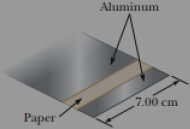
Physics for Scientists and Engineers
10th Edition
ISBN: 9781337553278
Author: Raymond A. Serway, John W. Jewett
Publisher: Cengage Learning
expand_more
expand_more
format_list_bulleted
Concept explainers
Textbook Question
Chapter 25, Problem 27P
A commercial capacitor is to be constructed as shown in Figure P25.27. This particular capacitor is made from two strips of aluminum foil separated by a strip of paraffin-coated paper. Each strip of foil and paper is 7.00 cm wide. The foil is 0.004 00 mm thick, and the paper is 0.025 0 mm thick and has a dielectric constant of 3.70. What length should the strips have if a capacitance of 9.50 × 10−8 F is desired before the capacitor is rolled up? (Adding a second strip of paper and rolling the capacitor would effectively double its capacitance by allowing charge storage on both sides of each strip of foil.)
Figure P25.27

Expert Solution & Answer
Trending nowThis is a popular solution!

Students have asked these similar questions
3AA . not sure what i am getting wrong
6b
1a angle of -A and 6b angle of A and Angle of -A. Need help
Chapter 25 Solutions
Physics for Scientists and Engineers
Ch. 25.1 - A capacitor stores charge Q at a potential...Ch. 25.2 - Many computer keyboard buttons are constructed of...Ch. 25.3 - Two capacitors are identical. They can be...Ch. 25.4 - You have three capacitors and a battery. In which...Ch. 25.5 - If you have ever tried to hang a picture or a...Ch. 25 - (a) When a battery is connected to the plates of a...Ch. 25 - Two conductors having net charges of +10.0 C and...Ch. 25 - When a potential difference of 150 V is applied to...Ch. 25 - An air-filled parallel-plate capacitor has plates...Ch. 25 - A variable air capacitor used in a radio tuning...
Ch. 25 - Review. A small object of mass m carries a charge...Ch. 25 - Find the equivalent capacitance of a 4.20-F...Ch. 25 - Why is the following situation impossible? A...Ch. 25 - A group of identical capacitors is connected first...Ch. 25 - Three capacitors are connected to a battery as...Ch. 25 - Four capacitors are connected as shown in Figure...Ch. 25 - (a) Find the equivalent capacitance between points...Ch. 25 - Find the equivalent capacitance between points a...Ch. 25 - You are working at an electronics fabrication...Ch. 25 - Two capacitors give an equivalent capacitance of...Ch. 25 - Two capacitors give an equivalent capacitance of...Ch. 25 - A 3.00-F capacitor is connected to a 12.0-V...Ch. 25 - Two capacitors, C1 = 18.0 F and C2 = 36.0 F, are...Ch. 25 - Two identical parallel-plate capacitors, each with...Ch. 25 - Two identical parallel-plate capacitors, each with...Ch. 25 - Two capacitors, C1 = 25.0 F and C2 = 5.00 F, are...Ch. 25 - A parallel-plate capacitor has a charge Q and...Ch. 25 - Consider two conducting spheres with radii R1 and...Ch. 25 - A supermarket sells rolls of aluminum foil,...Ch. 25 - Determine (a) the capacitance and (b) the maximum...Ch. 25 - The voltage across an air-filled parallel-plate...Ch. 25 - A commercial capacitor is to be constructed as...Ch. 25 - Each capacitor in the combination shown in Figure...Ch. 25 - A 2.00-nF parallel-plate capacitor is charged to...Ch. 25 - An infinite line of positive charge lies along the...Ch. 25 - A small object with electric dipole moment p is...Ch. 25 - The general form of Gausss law describes how a...Ch. 25 - You are working in a laboratory, using very...Ch. 25 - Four parallel metal plates P1, P2, P3, and P4,...Ch. 25 - A uniform electric field E = 3 000 V/m exists...Ch. 25 - Two large, parallel metal plates, each of area A,...Ch. 25 - A parallel-plate capacitor with vacuum between its...Ch. 25 - Why is the following situation impossible? A...Ch. 25 - Two square plates of sides are placed parallel to...Ch. 25 - (a) Two spheres have radii a and b, and their...Ch. 25 - Assume that the internal diameter of the...Ch. 25 - A parallel-plate capacitor of plate separation d...Ch. 25 - To repair a power supply for a stereo amplifier,...Ch. 25 - Example 25.1 explored a cylindrical capacitor of...Ch. 25 - You are part of a team working in a machine parts...Ch. 25 - Consider two long, parallel, and oppositely...Ch. 25 - Some physical systems possessing capacitance...Ch. 25 - A parallel-plate capacitor with plates of area LW...Ch. 25 - A capacitor is constructed from two square,...Ch. 25 - This problem is a continuation of Problem 45. You...
Knowledge Booster
Learn more about
Need a deep-dive on the concept behind this application? Look no further. Learn more about this topic, physics and related others by exploring similar questions and additional content below.Similar questions
arrow_back_ios
SEE MORE QUESTIONS
arrow_forward_ios
Recommended textbooks for you
 Physics for Scientists and Engineers: Foundations...PhysicsISBN:9781133939146Author:Katz, Debora M.Publisher:Cengage Learning
Physics for Scientists and Engineers: Foundations...PhysicsISBN:9781133939146Author:Katz, Debora M.Publisher:Cengage Learning Physics for Scientists and Engineers with Modern ...PhysicsISBN:9781337553292Author:Raymond A. Serway, John W. JewettPublisher:Cengage Learning
Physics for Scientists and Engineers with Modern ...PhysicsISBN:9781337553292Author:Raymond A. Serway, John W. JewettPublisher:Cengage Learning Physics for Scientists and EngineersPhysicsISBN:9781337553278Author:Raymond A. Serway, John W. JewettPublisher:Cengage Learning
Physics for Scientists and EngineersPhysicsISBN:9781337553278Author:Raymond A. Serway, John W. JewettPublisher:Cengage Learning
 College PhysicsPhysicsISBN:9781285737027Author:Raymond A. Serway, Chris VuillePublisher:Cengage Learning
College PhysicsPhysicsISBN:9781285737027Author:Raymond A. Serway, Chris VuillePublisher:Cengage Learning Principles of Physics: A Calculus-Based TextPhysicsISBN:9781133104261Author:Raymond A. Serway, John W. JewettPublisher:Cengage Learning
Principles of Physics: A Calculus-Based TextPhysicsISBN:9781133104261Author:Raymond A. Serway, John W. JewettPublisher:Cengage Learning

Physics for Scientists and Engineers: Foundations...
Physics
ISBN:9781133939146
Author:Katz, Debora M.
Publisher:Cengage Learning

Physics for Scientists and Engineers with Modern ...
Physics
ISBN:9781337553292
Author:Raymond A. Serway, John W. Jewett
Publisher:Cengage Learning

Physics for Scientists and Engineers
Physics
ISBN:9781337553278
Author:Raymond A. Serway, John W. Jewett
Publisher:Cengage Learning


College Physics
Physics
ISBN:9781285737027
Author:Raymond A. Serway, Chris Vuille
Publisher:Cengage Learning

Principles of Physics: A Calculus-Based Text
Physics
ISBN:9781133104261
Author:Raymond A. Serway, John W. Jewett
Publisher:Cengage Learning
Physics Capacitor & Capacitance part 7 (Parallel Plate capacitor) CBSE class 12; Author: LearnoHub - Class 11, 12;https://www.youtube.com/watch?v=JoW6UstbZ7Y;License: Standard YouTube License, CC-BY